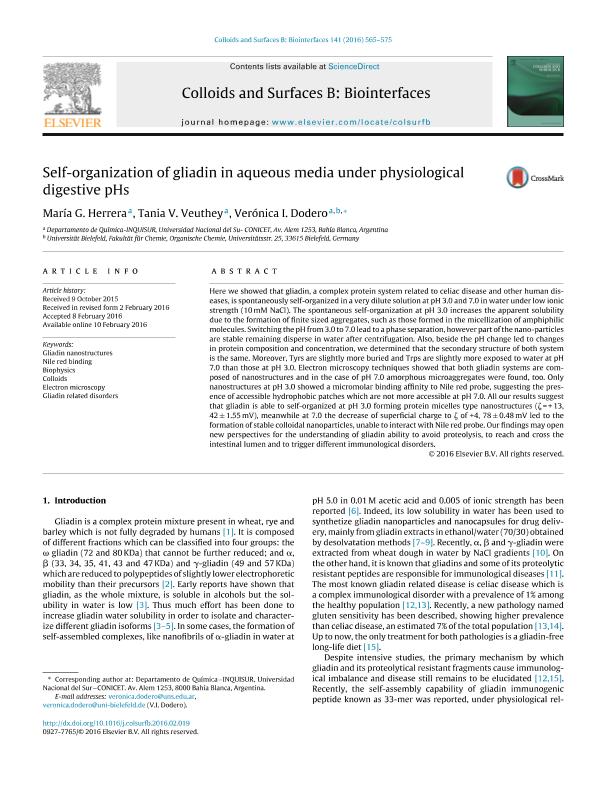Mostrar el registro sencillo del ítem
dc.contributor.author
Herrera, Maria Georgina

dc.contributor.author
Veuthey, Tania Vanesa

dc.contributor.author
Dodero, Veronica Isabel

dc.date.available
2018-08-03T20:47:24Z
dc.date.issued
2016-05
dc.identifier.citation
Herrera, Maria Georgina; Veuthey, Tania Vanesa; Dodero, Veronica Isabel; Self-organization of gliadin in aqueous media under physiological digestive pHs; Elsevier Science; Colloids and Surfaces B: Biointerfaces; 141; 5-2016; 565-575
dc.identifier.issn
0927-7765
dc.identifier.uri
http://hdl.handle.net/11336/54173
dc.description.abstract
Here we showed that gliadin, a complex protein system related to celiac disease and other human diseases, is spontaneously self-organized in a very dilute solution at pH 3.0 and 7.0 in water under low ionic strength (10 mM NaCl). The spontaneous self-organization at pH 3.0 increases the apparent solubility due to the formation of finite sized aggregates, such as those formed in the micellization of amphiphilic molecules. Switching the pH from 3.0 to 7.0 lead to a phase separation, however part of the nano-particles are stable remaining disperse in water after centrifugation. Also, beside the pH change led to changes in protein composition and concentration, we determined that the secondary structure of both system is the same. Moreover, Tyrs are slightly more buried and Trps are slightly more exposed to water at pH 7.0 than those at pH 3.0. Electron microscopy techniques showed that both gliadin systems are composed of nanostructures and in the case of pH 7.0 amorphous microaggregates were found, too. Only nanostructures at pH 3.0 showed a micromolar binding affinity to Nile red probe, suggesting the presence of accessible hydrophobic patches which are not more accessible at pH 7.0. All our results suggest that gliadin is able to self-organized at pH 3.0 forming protein micelles type nanostructures (ζ = + 13, 42 ± 1.55 mV), meanwhile at 7.0 the decrease of superficial charge to ζ of +4, 78 ± 0.48 mV led to the formation of stable colloidal nanoparticles, unable to interact with Nile red probe. Our findings may open new perspectives for the understanding of gliadin ability to avoid proteolysis, to reach and cross the intestinal lumen and to trigger different immunological disorders.
dc.format
application/pdf
dc.language.iso
eng
dc.publisher
Elsevier Science

dc.rights
info:eu-repo/semantics/openAccess
dc.rights.uri
https://creativecommons.org/licenses/by-nc-sa/2.5/ar/
dc.subject
Biophysics
dc.subject
Colloids
dc.subject
Electron Microscopy
dc.subject
Gliadin Nanostructures
dc.subject
Gliadin Related Disorders
dc.subject
Nile Red Binding
dc.subject.classification
Otras Ciencias Químicas

dc.subject.classification
Ciencias Químicas

dc.subject.classification
CIENCIAS NATURALES Y EXACTAS

dc.title
Self-organization of gliadin in aqueous media under physiological digestive pHs
dc.type
info:eu-repo/semantics/article
dc.type
info:ar-repo/semantics/artículo
dc.type
info:eu-repo/semantics/publishedVersion
dc.date.updated
2018-08-01T14:28:36Z
dc.journal.volume
141
dc.journal.pagination
565-575
dc.journal.pais
Países Bajos

dc.journal.ciudad
Amsterdam
dc.description.fil
Fil: Herrera, Maria Georgina. Consejo Nacional de Investigaciones Científicas y Técnicas. Centro Científico Tecnológico Conicet - Bahía Blanca. Instituto de Química del Sur. Universidad Nacional del Sur. Departamento de Química. Instituto de Química del Sur; Argentina
dc.description.fil
Fil: Veuthey, Tania Vanesa. Consejo Nacional de Investigaciones Científicas y Técnicas. Centro Científico Tecnológico Conicet - Bahía Blanca. Instituto de Química del Sur. Universidad Nacional del Sur. Departamento de Química. Instituto de Química del Sur; Argentina
dc.description.fil
Fil: Dodero, Veronica Isabel. Consejo Nacional de Investigaciones Científicas y Técnicas. Centro Científico Tecnológico Conicet - Bahía Blanca. Instituto de Química del Sur. Universidad Nacional del Sur. Departamento de Química. Instituto de Química del Sur; Argentina. Universitat Bielefeld; Alemania
dc.journal.title
Colloids and Surfaces B: Biointerfaces

dc.relation.alternativeid
info:eu-repo/semantics/altIdentifier/doi/http://dx.doi.org/10.1016/j.colsurfb.2016.02.019
dc.relation.alternativeid
info:eu-repo/semantics/altIdentifier/url/https://www.sciencedirect.com/science/article/pii/S0927776516300984
Archivos asociados
